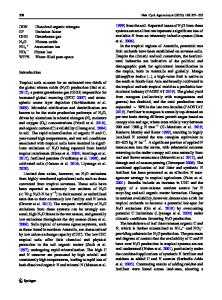Enhanced nitrous oxide emissions caused by atmospheric nitrogen deposition in agroecosystems over China
- PDF / 3,911,131 Bytes
- 11 Pages / 595.276 x 790.866 pts Page_size
- 75 Downloads / 302 Views
RESEARCH ARTICLE
Enhanced nitrous oxide emissions caused by atmospheric nitrogen deposition in agroecosystems over China Yuyu Yang 1 & Lei Liu 1
&
Feng Zhang 2 & Xiuying Zhang 3 & Wen Xu 4 & Xuejun Liu 4 & Yi Li 5 & Zhen Wang 3 & Yaowen Xie 1
Received: 7 June 2020 / Accepted: 9 November 2020 # Springer-Verlag GmbH Germany, part of Springer Nature 2020
Abstract Atmospheric nitrogen (N) deposition in China has been the largest worldwide. Yet the impacts of atmospheric N deposition on soil N2O emissions were often ignored by previous studies. Thus, we investigated how N deposition affected N2O emissions over China using the process-based model (DNDC, DeNitrification-DeComposition). Total soil N inputs were 194 kg N ha−1 in agricultural systems over China in 2010, including chemical N fertilizer (78%), atmospheric N deposition (12%), and crop residues N (10%). Annual N2O emissions induced by N deposition were estimated at 97 Gg N, occupying 43% of total soil N2O emissions (228 Gg N) in agricultural systems over China. In particular, the largest N2O emissions caused by atmospheric N deposition were found in South China, followed by North China Plain and Southwest China. The efficiency of N deposition generating N2O emissions (3.0%) over China was 4 times than that of N fertilizer (0.7%). N2O emissions induced by N deposition increased from 81 Gg in 2000 to 93 Gg in 2014 (by 1% yr−1), which was consistent with the long-term trend of N deposition. This suggests N deposition accelerated soil N2O emissions largely contributing to global warming. Our results also indicated that 62% and 10% of soil N2O emissions were reduced by applying a nitrification inhibitor and N fertilizer with 20% decrease. We highlight the significance of considering N deposition in determining total soil N2O emissions over China. The results provide an important scientific basis for the prediction of greenhouse effect caused by N deposition over China. Keywords Nitrous oxide emissions . Nitrogen deposition . Nitrogen fertilizer . Nitrogen managements
Introduction
Responsible Editor: Gerhard Lammel * Lei Liu [email protected] * Yaowen Xie [email protected] 1
College of Earth and Environmental Sciences, Lanzhou University, Lanzhou 730000, China
2
State Key Laboratory of Grassland Agro-ecosystems, Institute of Arid Agroecology, School of Life Sciences, Lanzhou University, Lanzhou 730000, Gansu, China
3
International Institute for Earth System Science, Nanjing University, Nanjing 210023, China
4
College of Resources and Environmental Sciences, National Academy of Agriculture Green Development, China Agricultural University, Beijing 100193, China
5
SailBri Cooper Inc., Beaverton, OR 97008, USA
Nitrogen (N) cycling is strongly perturbed by human activities, such as application of N fertilizer, energy production, industries, and transportations (Wang et al. 2019). Elevated reactive N (Nr, NOx plus NH3) emissions into the environment have led to increased atmospheric nitrous oxide (N2O) emissions by 20% in recent decades (Tian et al. 2019;
Data Loading...











